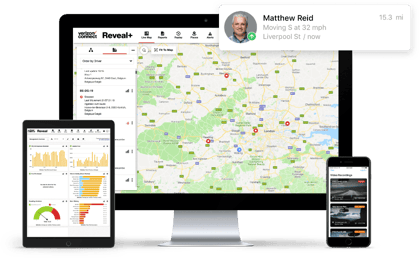Build your advanced fleet safety programme
Develop an advanced fleet safety programme to improve driver behaviour, reduce accidents, and enhance overall safety...
Read more
Gross vehicle weight ratings (GVWR) are critical for fleet managers to understand and utilise for fleet safety and compliance.
Overloading a HGV and not staying compliant with gross vehicle weight ratings can impact fleet safety directly. According to the Government of the UK, “lorries which are loaded beyond their design weight are less able to stop quickly in an emergency and the steering of the vehicle can be affected” (1).
Also, they “estimated that the overloading of good vehicles costs the community over £50M a year through additional wear and tear to roads and bridges. Heavy axles cause proportionately far more wear and tear, and overloading drive axles (legal limit 11.5 tonnes) are the biggest single cause of excessive wear and tear on roads” (2).
If we dive into safety, ignoring these vehicle ratings can have dire consequences. In fact, according to research, the heavier the vehicle, “the more likely it is to be in a crash, and loading is a contributing cause of rollovers” (3).
In fact, those vehicles that exceed the weight rating “will have a dramatic effect on performance. Steering, maneuverability, braking and acceleration are all affected” (4) and can increase the risk of crashes and road accidents.
Here’s what fleet managers need to know about GVWR to protect the integrity of their vehicles and the safety of their drivers and others on the road.
Gross Vehicle Weight Rating (GVWR) is the maximum allowable weight a vehicle can safely support, as determined by the vehicle’s manufacturer.
The gross vehicle weight rating includes the weight of the vehicle itself, passengers, fuel and additional accessories or equipment, such as toolboxes, bed liners, truck racks and cargo slides. The rating is typically found on a HGVs door jamb or the inside of the door and can be labeled as gross vehicle weight rating, GVWR or gross weight.
Adhering to the GVWR helps curb excessive wear and tear on vehicle parts and reduces the risk and severity of crashes. However, this is not the only weight information you need to determine if your vehicle is properly loaded.
{{Mid-CTA}} Fleet managers are increasingly turning to fleet technologies to help manage maintenance and find cost savings—see how much in our 2025 Fleet Technology Trends Report UK . [LINK TBD]
In addition to GVWR, several other weight-related metrics are essential for fleet management:
These classifications are essential for ensuring that fleet vehicles operate within safe weight limits, which can help reduce the possibility of breakdowns and meet compliance with federal and state regulations, particularly new emissions regulations whose rules are based around GVWR.
Years ago, adding the gross axle weight rating together for all axles was a common way of calculating GVWR, but that’s no longer the case and is now an inaccurate way of determining gross vehicle weight ratings.
Today, establishing a vehicle’s GVWR is more complicated because manufacturers cannot just consider component parts, but also safety system standards and how vehicles meet those standards. That is why you may see gross vehicle weight ratings that are lower than the sum of the axle ratings.
Adhering to GVWR is critical for fleet safety. Overloaded vehicles can encounter drivability issues, reduced reliability and heightened maintenance problems. Even if you are not exceeding the weight limits, drivers should be aware of their vehicle’s gross weight limit and how close it is to the maximum rate so they can adjust their driving accordingly.
Adhering to gross vehicle weight rate can potentially reduce the following:
Understanding and adhering to GVWR can also reduce your potential liability in a crash and demonstrate commitment to compliance because you have followed the manufacturer's recommendations and met your legal obligation regarding load limits.
If you’ve got fleet safety on your mind, fleet management software like GPS tracking and dashcam video can also help you drive a safer tomorrow through vehicle tracking, maintenance and driver coaching.
If you want to see how fleet management can help you achieve safety goals, set up a demo today.
Sources:
Tags: Safety




Find out how our platform gives you the visibility you need to get more done.
Develop an advanced fleet safety programme to improve driver behaviour, reduce accidents, and enhance overall safety...
Read moreWe surveyed more than 200 fleet managers in The United Kingdom to learn more about the trends and insights within the...
Read moreUsing Vision Zero in your fleet safety programme can help reduce road fatalities and serious injuries. Find out how.
Read moreHere are four ways to focus on fleet safety, including new video-based driver coaching features from Verizon Connect.
Read more